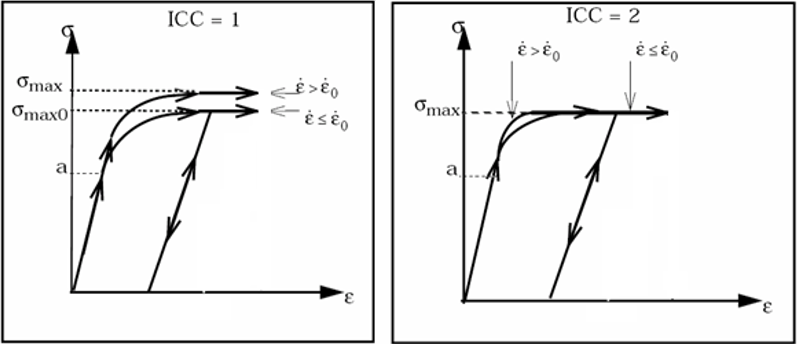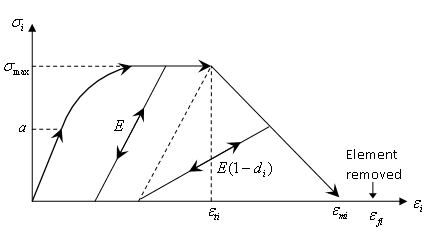/MAT/LAW27 (PLAS_BRIT)
Block Format Keyword This law combines an isotropic elasto-plastic Johnson-Cook material model with an orthotropic brittle failure model. Material damage is accounted for prior to failure. Failure and damage occur only in tension. This law is applicable only for shells.
Format
| (1) | (2) | (3) | (4) | (5) | (6) | (7) | (8) | (9) | (10) |
|---|---|---|---|---|---|---|---|---|---|
| /MAT/LAW27/mat_ID/unit_ID or /MAT/PLAS_BRIT/mat_ID/unit_ID | |||||||||
| mat_title | |||||||||
| E | |||||||||
| a | b | n | |||||||
| c | ICC | Fsmooth | Fcut | ||||||
| dmax1 | |||||||||
| dmax2 | |||||||||
Definitions
| Field | Contents | SI Unit Example |
|---|---|---|
| mat_ID | Material
identifier. (Integer, maximum 10 digits) |
|
| unit_ID | Unit Identifier. (Integer, maximum 10 digits) |
|
| mat_title | Material
title. (Character, maximum 100 characters) |
|
| Initial
density. (Real) |
||
| E | Young's
modulus. (Real) |
|
| Poisson's
ratio. (Real) |
||
| a | Plasticity yield
stress. (Real) |
|
| b | Plasticity hardening
parameter. (Real) |
|
| n | Plasticity hardening
exponent. (Real) |
|
| Plasticity maximum
stress. Default = 1030 (Real) |
||
| c | Strain rate coefficient.
Default = 0.00 (Real) |
|
| Reference strain
rate. If , no strain rate effect. (Real) |
||
| ICC | Strain rate computation
flag. 4
(Integer) |
|
| Fsmooth | Strain rate smoothing flag.
(Integer) |
|
| Fcut | Cutoff frequency for
strain rate smoothing. 5 Default = 1030 (Real) |
|
| Tensile failure strain at
which stress starts to reduce in the principal strain direction 1.
6 Default = 1.0 x 1030 (Real) |
||
| Maximum tensile failure
strain in principal strain direction 1 at which the stress in the
element is set to a value dependent on
dmax1.
6 Default = 1.1 x 1030 (Real) |
||
| dmax1 | Maximum damage factor in
principal strain direction 1. 6 Default = 0.999 (Real) |
|
| Maximum tensile strain for
element deletion in principal strain direction 1. 6 Default = 1.2 x 1030 (Real) |
||
| Tensile failure strain at
which stress starts to reduce in the principal strain direction
2. Default = 1.0 x 1030 (Real) |
||
| Maximum tensile strain in
principal strain direction 2 at which the stress in the element is
set to a value dependent on
dmax2. Default = 1.1 x 1030 (Real) |
||
| dmax2 | Maximum damage factor in
principal strain direction 2. 6 Default = 0.999 (Real) |
|
| Maximum tensile strain for
element deletion in principal strain direction 2. Default = 1.2 x 1030 (Real) |
Example (Aluminum)
#RADIOSS STARTER
#---1----|----2----|----3----|----4----|----5----|----6----|----7----|----8----|----9----|---10----|
/UNIT/1
unit for mat
Mg mm ms
#---1----|----2----|----3----|----4----|----5----|----6----|----7----|----8----|----9----|---10----|
#- 2. MATERIALS:
#---1----|----2----|----3----|----4----|----5----|----6----|----7----|----8----|----9----|---10----|
/MAT/PLAS_BRIT/1/1
Aluminum
# RHO_I
.0027
# E NU
60400 .33
# a b n SIG_max0
90.266 223.14 .375 177
# c EPS_DOT_0 ICC Fsmooth F_cut
0 0 0 0 0
# EPS_t1 EPS_m1 d_max1 EPS_f1
.16 .72 .999 1
# EPS_t2 EPS_m2 d_max2 EPS_f2
0 0 0 0
#---1----|----2----|----3----|----4----|----5----|----6----|----7----|----8----|----9----|---10----|
#ENDDATA
/END
#---1----|----2----|----3----|----4----|----5----|----6----|----7----|----8----|----9----|---10----|Comments
- In this model, the material behaves as
a linear-elastic material when the equivalent stress is lower than the plastic
yield stress. For higher stress values, the material behavior is plastic and the
stress is calculated as.
(1) Where,- Plastic strain
- Strain rate
The plasticity hardening exponent, n must be less than 1.
- This law allows the modeling of material damage and brittle failure in two principal directions (1 and 2).
- This law is only applicable to shell elements. It is compatible with Shell Property (/PROP/TYPE1) and Sandwich Shell Property (/PROP/TYPE11).
- The ICC flag defines the effect
of strain rate on the maximum material stress
. Figure 1 shows the value of
for the corresponding ICC flag.

Figure 1. - Strain rate smoothing is a process used to filter out higher strain rate frequencies.
- When principal strain
becomes higher than
, then damage between
and
is controlled by the damage factor
, which is given by the following equation.
in directions, = 1, 2.
Stress is reduced according to damage parameter . Damage is reversible between and . When , damage is set to and it is not updated further.
Figure 2.